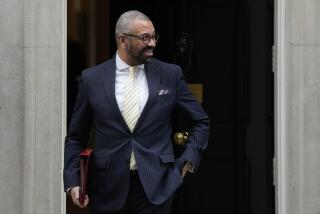Australia Faces Up to Immigration Issue
- Share via
SYDNEY — Australia, a nation built on successive waves of migrants, has never found it easy to come to grips with immigration.
“In over 200 years there has always been the argument from those already here that no one else should come,” said Carl Harbaum, chairman of the Federation of Ethnic Communities’ Councils of Australia.
The immigration debate bubbled to the surface again in May, although this time the discussion was based more on economics than emotion.
Some of Australia’s most senior politicians and academics called for a cut, or at the very least a reassessment, of the present immigration policy, which increases the population by about 1% a year. Australia’s current population is about 16 million.
Most previous attempts to stage a debate on immigration have degenerated into vitriolic shouting matches.
This time, however, the charges of racism against those who dared call for a cut in immigration were conspicuously absent.
“I welcome any informed and unprejudiced debate in this country about immigration,” Prime Minister Bob Hawke told a news conference. “I have a commitment to immigration and what it has meant to this country, but that doesn’t mean I think there is a sacredness about this issue which precludes debate.”
Peter Walsh, a former finance minister, rekindled the debate by saying Australia’s record level of immigration was fueling demand in an overheated economy and had to be cut.
Australia allows 150,000 migrants entry each year. Immigration officials say that in relation to total population Australia is taking in more immigrants per capita than any other nation except Israel.
“It is beyond any reasonable doubt that the present immigration program is seriously aggravating our short- and medium-term economic problems,” Walsh said.
Until 1959 Australia conducted a “white” immigration policy. Today more than 40% of its immigrants come from Asia, compared to 19.3% from Britain and Ireland and 5.2% from Europe.
For Australian governments increasingly faced with a vocal and highly politicized ethnic community, determining the rate and composition of immigration has become a political nightmare in the last two decades.
“In the late ‘70s and ‘80s migration became a sacred cow and now to challenge it means you are labeled a racist,” said Robert Birrell, a senior sociology lecturer at Monash University.
“They (ethnic leaders) can’t differentiate between an opinion on immigration and an opinion on migrants. They take it very personally.”
Former Immigration Minister Stewart West called for a reassessment of the annual intake on economic grounds, saying the present rate could be cut by 40,000.
“You have to ask yourself: Does it make sense to bring 140,000 to 150,000 people a year in, now that we are sliding into recession?” West said.
Birrell said current urban planning is inadequate for the high level of immigration. He said 40% of migrants settle in Sydney, which is already suffering from a chronic housing shortage, sewerage problems and transport strains.
That argument was rejected by Brian Parmenter, deputy director of Melbourne University’s Institute of Applied Economic and Social Research.
“The majority view of economists is that the mechanism mentioned by Walsh is important, but there are still many other issues to be debated,” Parmenter said.
He said, for example, that in 1989 migrants brought some $1.9 billion into the country and that the accumulated capital migrants bring into Australia would offset any balance of payment pressures.
Australia’s migration program actively recruits migrants with business skills and up to $650,000 to invest. About 10,200 people received visas under that part of the program in the year which ended June 30, 1989, immigration officials say.
“So far,” said Harbaum, “there is no indication of racial prejudice coming up in the arguments for and against (immigration)--it’s been kept at the purely economic level.”
More to Read
Sign up for Essential California
The most important California stories and recommendations in your inbox every morning.
You may occasionally receive promotional content from the Los Angeles Times.













